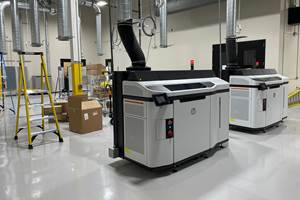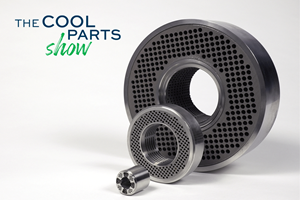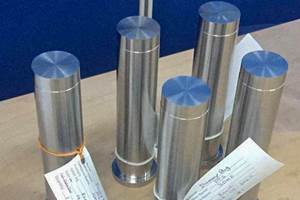How Additive Manufacturing Can Benefit from Blockchain: AM Radio #15B
Blockchain technology isn’t only suitable for protecting cryptocurrency and NFTs. This week’s episode of the AM Radio podcast looks at how blockchain is being applied to 3D printable files today, and how far this pairing could go.
Share
The distributed ledger system known as blockchain is the technology that makes possible ownership of intangible items like cryptocurrency and nonfungible tokens (NFTs). But this same technology could also be the backbone for protecting, authenticating and distributing the manufacture of 3D printable files. Blockchain could help creators and designers protect their work, while also enabling IP owners to share their designs for controlled additive manufacturing elsewhere.
In this week’s episode of the AM Radio podcast, I discuss blockchain for additive manufacturing with cohost Julia Hider. We look at several solutions for AM being built on blockchain technology, and also explore how this system could change the relationship between designers and manufacturers with the help of an example from TikTok. Listen to the segment above, find the show wherever you get podcasts or read on for the transcript.
Transcript
Julia Hider
This episode of The AM Radio podcast is brought to you by CompositesWorld, a sister media brand to Additive Manufacturing Media. CW follows what's new and trending and design tooling materials and fabrication of fiber reinforced composites, including how the industry is changing with additive manufacturing. Learn more about innovations in end markets, including aerospace, automotive, marine and wind energy. Find more information in the CompositesWorld magazine, newsletters, CWTalks podcast, annual Carbon Fiber Conference, and much more at compositesworld.com.
Stephanie Hendrixson
And we're back. In the first half of the show, Julia Hider and I were talking about how 3D printing composites are replacing metal parts. Now we're going to kind of totally change gears talk about something that's a lot less tangible. Julia, I want to talk about blockchain.
Julia Hider
Okay. Stephanie, blockchain is something I think I understand maybe, but why don't you explain it to me again, and to everyone else, just to make sure that we're all on the same page here.
Stephanie Hendrixson
Right. So like, if you haven't bought an NFT or gotten to crypto lately, I'm going to try to do like the simplified version of what blockchain is. So essentially, is this distributed digital ledger that records transactions. So you have these blocks, which are used to store information and they have like a limited amount of storage. And so as you fill one block, you get more blocks, and they just keep getting added to this chain.
The way I always think about it is our colleague, Mark Albert, who is now editor emeritus of Modern Machine Shop, a couple of years ago wrote this explanation of what blockchain is. And it's just stuck in my mind ever since we'll put it in the show notes. But he basically said it's sort of like a check ledger. So I don't write a lot of checks these days. But you know, back when this was the way that I paid my rent, it was like, I would write the check to my landlord, and then record it in the check register and say, like the cheque number, how much it was, what date it was paid. And so the blockchain kind of works, like if I were to give that cheque to my landlord, and also give him the check register along with it. And so like the record of that transaction travels with the asset, and so you end up with like copies of this transaction record with various different people in various different places. And so it becomes very difficult to falsify or fabricate transactions. Because these ledgers exist all over the place. As things change hands copies are made. And then to change something in the ledger, you would have to get everyone else to like collude with you to also change their records. And so you can use blockchain as a way to ensure that files are accurate, that they are authentic.
You know, this, again, is what cryptocurrency is built on. It's what NFT's are built on. And so you can use it to protect assets in this way. And so I've been thinking about blockchain and its relationship to additive manufacturing for a couple of reasons. One is that I've been working on this story that has to do with Blockchain, which should be out by the time this episode airs. So we'll put that in the show notes. But basically, I've been working with a guy named Johannes Schweifer. He's the founder and CEO of this company called CoreLedger in Europe. They're based in Liechtenstein and Switzerland. And basically what CoreLedger does is they've created these ready-made blockchain solutions. And they work with like small and medium businesses to customize those solutions. So that these companies can use blockchain without having their own team of developers without figuring out all this stuff on their own. And so last year, in 2021, they got involved in this project within the EU to try and find new business models with 3D printing, they were working with a team of multiple partners. And they created this solution specifically geared towards 3D printing. And it accomplishes three different things. So first, they were able to secure 3D printable files with something called file hashing, basically, creating a fingerprint that's unique to each file, I'm going to oversimplify it, but it sort of looks at the data that's in the file to create the fingerprint. And so if something changes within that file, the fingerprint would also change. And so that's a way of ensuring that this STL or whatever it is, hasn't been tampered with, by the time it gets to you. The hash, the fingerprint is actually what gets stored in the blockchain and the files live elsewhere. The second thing was to make sure that only the person that you want to send this to can decrypt the information. And so they figured out how to do that through tokens. And then finally, and this was the hardest part, they figured out a way to account for the different 3D printing runs. So they wanted OEMs, or whoever owns the design of this part to be able to restrict the number of prints that could be made. So in this system, each print you want to make costs a token.
So if I designed a widget and you, Julia, wanted to print some, I'd say Julia, how many do you want to make?
Julia Hider
Five.
Stephanie Hendrixson
Okay, and so that'll cost you five tokens. When you have printed your five parts, you can't print anymore, you lose access to that design. However, as we know, with 3D printing, things don't always go exactly as planned, especially in the first try. And so they actually did create a system where if a build fails, and you have a bad print, it should allow you to print a replacement, but you are restricted to the number of items that you originally purchased, basically.
Julia Hider
Yeah, that's really interesting. I mean, this is such a trendy topic right now. Do you know of any other examples of you know, additive manufacturing using blockchain?
Stephanie Hendrixson
Yeah, there are some other groups working on this, there was a story I wrote last year on a U.S.-based company out there called VeriTX and they were trying to figure out how to use blockchain to build like a marketplace. And so this would be a place where OEMs could upload their files, and then manufacturers that had like the right equipment and the right permissions could then buy them. And specifically, very Texas is focused on aerospace parts. So this would be you know, a scenario where if you're such and such machine shop at such and such air force base, and you need a part, you could go into this marketplace, and if you have the right permissions and the right equipment, you could buy it using blockchain and get a secure file sent to you. So there are a lot of different ways that this could play out and different ways people are exploring blockchain for additive. The other reason I've been thinking about this recently, though, is that there's been this news story going around about a tick tock or who created a 3D printable file. His name's Andrew Martin, he goes by Monster Caesar Studios on TikTok. And a couple years ago, he was inspired by this sculpture of a tiki drummer that's used in the Enchanted Tiki Room at Disney theme parks,
Julia Hider
I could go for a tiki drink right now.
Stephanie Hendrixson
And so he made this fan art 3D model of this sculpture and like it's not identical to the original, obviously, like he made his own little tweaks to it. And because it's fan art, it's not something he can sell for a profit. So he just posted it to Thingiverse under a Creative Commons license, so that if other people were interested, they could download it and make their own. But again, it could not be sold because it is based on somebody else's IP. However, more recently, it seems that Disney is selling a souvenir Tiki drummer that looks very, very similar, if not identical to the model that he created those a couple of years ago.
Julia Hider
So yeah, I have the article pulled up right now we'll link to it in the show notes. But looking at the STL file and looking at the — it's a little music box with the tiki drummer, and they look pretty similar, right?
Stephanie Hendrixson
So I don't really want to get into like who's right and who's wrong in this situation. Listeners, if you want to check this out. Again, we will post it in the show notes, you can make your own judgment. But it just got me thinking about ways that creators could be able to protect their designs through blockchain and ways that transactions between people who own IP and people who want to make things based on that IP could go differently with bockchain. So if you think of it from the perspective of a creator, like Andrew, like let's say he does have an original design that he wants to sell to people in the future. If you had like a blockchain protected marketplace, you could put it up for sale and say one token is good for one print. And then someone would not be able to use the design or mass produce it without his knowledge or his consent. On the flip side, like Disney, or Sony or HBO or some other company that maybe wanted to sell a souvenir designed to customers could sell a blockchain protected file that says Yes, like this is an authentic design. It can be a collector's item when it's printed, I don't know exactly what it would be.
But I think getting beyond like the media conglomerates where I see this maybe going is you're dealing with companies like Whirlpool or Kenmore or IKEA or Dyson, where you're buying their product. And then they would maybe allow you to buy these 3D printable files that are protected by blockchain to make your own accessories or or do other things with their products. So you buy a Dyson vacuum, and then maybe you can also buy the file to make this particular special attachment that's designed for picking up the hair of whatever pet you have, or something like that, or maybe part of your washing machine breaks and then you can buy the right design from Whirlpool for the replacement part. But I think maybe it even gets beyond that. And maybe it's not individual consumers making these things. Maybe it's you're going down to your local 3D printing depot, buy the file, give it to them, let them make the part for you. And so I think blockchain just has the potential to get us to all these other things that we've been talking about with additive distributed manufacturing, make it on demand, make it near the customer, create this digital inventory. And I just got really interested in all the different ways that blockchain could be used alongside a digital manufacturing process like 3D printing.
Julia Hider
Yeah, that's a radically different supply chain model than we're looking at right now and totally transformed it because of 3D printing. Alright, I think that's a good place to wrap up this conversation and this episode of AM Radio. If you like the podcast make sure to subscribe so you get notified when we have a new episode out. And if you are on Spotify or Apple Podcasts make sure to give us a five-star rating. Thanks for listening everyone.
Stephanie Hendrixson
AM Radio is recorded with help from Austin Grogan. The show is edited by Alex Lytle and me Stephanie Hendrixson. Our artwork is by Kate Billberry. AM Radio and Additive Manufacturing Media are products of Gardner Business Media located in the Queen City, Cincinnati, Ohio. I'm Stephanie Hendrixson. Thanks for listening.
Related Content
What Does Additive Manufacturing Readiness Look Like?
The promise of distributed manufacturing is alluring, but to get there AM first needs to master scale production. GKN Additive’s Michigan facility illustrates what the journey might look like.
Read MoreBeehive Industries Is Going Big on Small-Scale Engines Made Through Additive Manufacturing
Backed by decades of experience in both aviation and additive, the company is now laser-focused on a single goal: developing, proving and scaling production of engines providing 5,000 lbs of thrust or less.
Read MoreVariable Resistance Valve Trim Achieves Lead Time Reduction Through AM: The Cool Parts Show #69
Baker Hughes is realizing shorter lead times and simplified manufacturing through powder bed fusion to produce valve trims previously assembled from many machined metal parts.
Read MoreConocoPhillips Sees Oil and Gas Supply Chain Opportunity With Additive Manufacturing
Production of parts when needed and where needed can respond to the oil and gas sector’s multibillion-dollar challenge of holding parts in inventory. The supply chain benefit will justify additive even before the design freedoms are explored.
Read MoreRead Next
Profilometry-Based Indentation Plastometry (PIP) as an Alternative to Standard Tensile Testing
UK-based Plastometrex offers a benchtop testing device utilizing PIP to quickly and easily analyze the yield strength, tensile strength and uniform elongation of samples and even printed parts. The solution is particularly useful for additive manufacturing.
Read MoreAlquist 3D Looks Toward a Carbon-Sequestering Future with 3D Printed Infrastructure
The Colorado startup aims to reduce the carbon footprint of new buildings, homes and city infrastructure with robotic 3D printing and a specialized geopolymer material.
Read MoreCrushable Lattices: The Lightweight Structures That Will Protect an Interplanetary Payload
NASA uses laser powder bed fusion plus chemical etching to create the lattice forms engineered to keep Mars rocks safe during a crash landing on Earth.
Read More
.jpg;width=70;height=70;mode=crop)



















